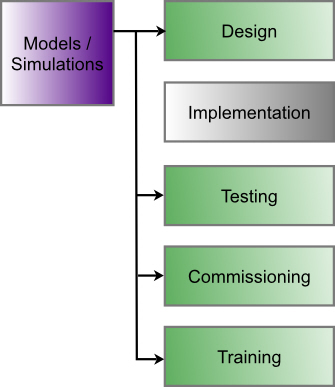Dynamic Modelling and Simulation
WHAT WE DO WHY MODELLING AND SIMULATION WHY USE US EXAMPLES OF OUR WORK CUSTOMER FEEDBACK
WHAT WE DO
"The very act of building models and producing a simulation adds to the engineers understanding of how to design a control a system. It reveals where the major disturbances, interactions, nonlinearities and problems are likely to arise."
Prof. Mike Grimble - Read more in Secrets of Model Based Control
We can purpose-build properly validated dynamic models and simulation to meet our clients' specific objectives, including:
- Engineering Support - to give confidence that design and/or operational changes will perform to the required specification thus reducing uncertainties.
- Front End Engineering Design (FEED) Studies - to enable the assessment of technical feasibility and cost thus increasing ability to get the design right first time.
- Hardware-in-the-Loop (HIL) - to enable effective, early testing of complex real-time embedded systems during the development process thus reducing risks and commissioning time.
- Training - to provide help plant operators and maintenance personnel familiarise with standard, routine operations and emergency procedures thus incresing confidence in dealing with both normal and abnormal or critical situations.
Models can be derived from first principles or plant data and we help clients understand the developed model to the depth they require and provide training if appropriate.
Types of Models We Develop
- Nonlinear Dynamic Models for Simulation - The model captures the behaviour of the plant/process, in a level of detail that is appropriate for the refinement of the controller that is to be designed. Our preferred or recommended model type is usually a grey-box model.
- Control-Oriented Models - In the case of a model-based controller e.g. model-based predictive control (MPC), a model with specific structure is a direct element within the controller. In the general case, for example a PID controller, the second-order model can be used in the design of the controller, e.g. to ensure specified gain- and phase-margins are met. These models can be obtained through either analytical derivation or system identification.
- Simulation for HIL - During the development of the main control software application, a software emulation of the physical system can be built to replicate the operating modes and anything that requires testing (e.g. ability to inject faults as defined in the System Test Specification). The ability to extensively test software (either during development or for later revisions or bug fixes) without the need to access the physical system or the real-time target can be very helpful, as testing on the real system is often limited. Read more ...
Why Use Modelling and Simulation
Systems of every type and their operating conditions are subject to variations, such as changes in products (new operating points etc.) and raw material sources, plant modifications, wear and tear of actuators (e.g. valves and drives), and degradation of measurement sensors.
It is impossible to test the control systems for every possible condition prior to deployment. Dynamic modelling and simulation thus play an important role in control systems development:
- Design - Modelling and simulation are an essential tool in the design stage especially where an advanced model-based control method is considered. Building models and producing a simulation adds to the engineers' understanding of how to design a control a system. It reveals where the major disturbances, interactions, nonlinearities and problems are likely to arise. In addition to aiding control design and tuning, they are valuable as a de-risking tool, ahead of the commissioning, to check for potential operational scenarios and issues and, where applicable, to assess the appropriate solutions so that modifications can be made before Factory Acceptance Testing and delivery to the customer.
- Testing and Commissioning - The model and simulation of a system can be used by the commissioning engineer to test the effect of varying controller settings before actual implementation, thus reducing the commissioning and control tuning time and lowering costs. This can be extremely valuable for large or high value systems where commissioning time is even more at a premium, particularly since software is usually the last thing installed. once the system is in-service, bug fixing and future software revisions are also easier to prove and test with simulation models.
- Training - Dynamic simulations can be used to help engineers and train operators in understanding the effect of control settings and actions on the actual process. These are therefore highly valuable for the operation of the installed control systems and for future upgrades.
Why Use Us
One vital aspect of using models and simulations is that their usefulness depends greatly on the quality of the models which should be neither too simple nor too complex but fit for purpose. The judgement on this however comes from the experience of those who build the models.
For 25 years, we have modelled and simulated a diversity of systems and processes to aid the troubleshooting of existing control systems and the development of effective control strategies and shortening of the design to deployment cycle. Our engineers have amassed rich experience in building well validated nonlinear dynamic models of mechanical, hydraulic, electrical, combustion, process, and chemical systems for applications from marine, power generation, automotive, to oil and gas and other process industries.
Tools We Use
Our engineers utilise a wide variety of modelling packages such as MATLAB/Simulink, LabVIEW and CD&SIM Toolkit, as well as Hysys.
In the case where the end-user does not wish to purchase a simulation package, and instead just needs to use the model, we can even provide standalone simulations.
We can also undertake work to convert legacy models into new modelling packages, including model conversion from Simulink to LabVIEW.
INDUSTRIES WE SERVE
Our modelling and simulation services are available to a range of industries:

Simulation for Control
